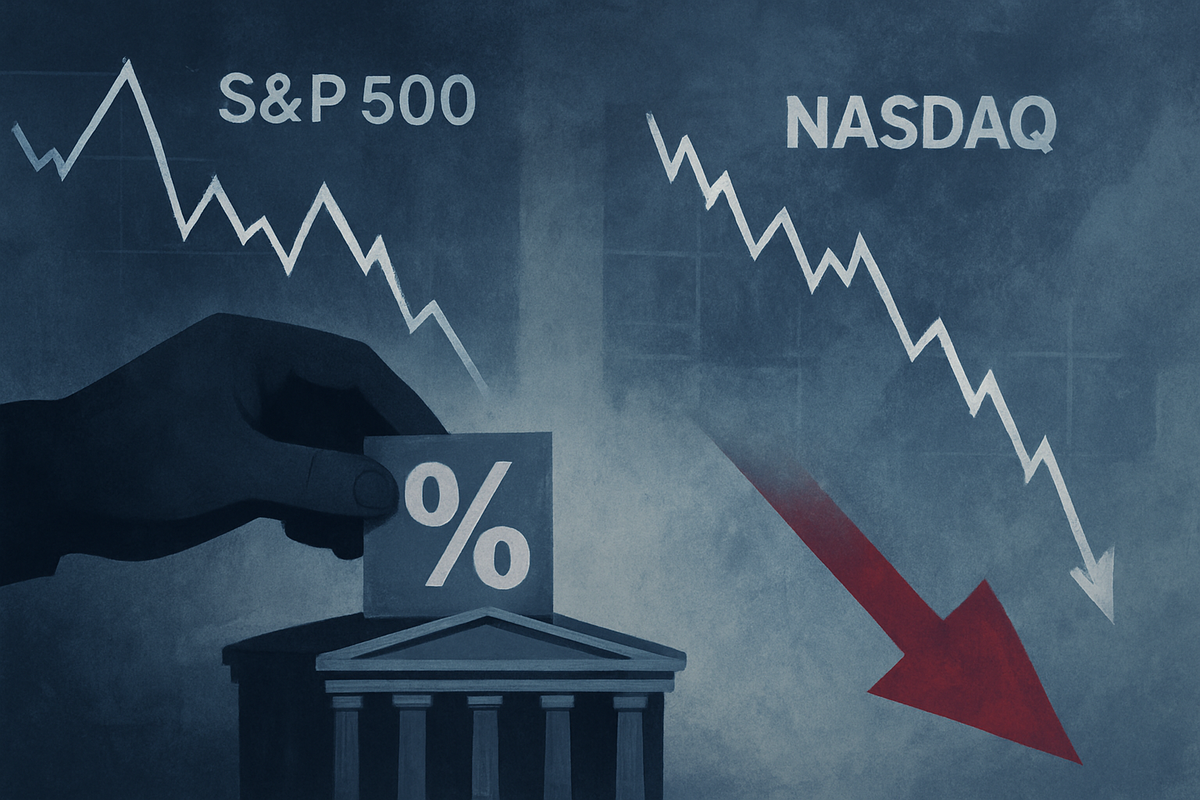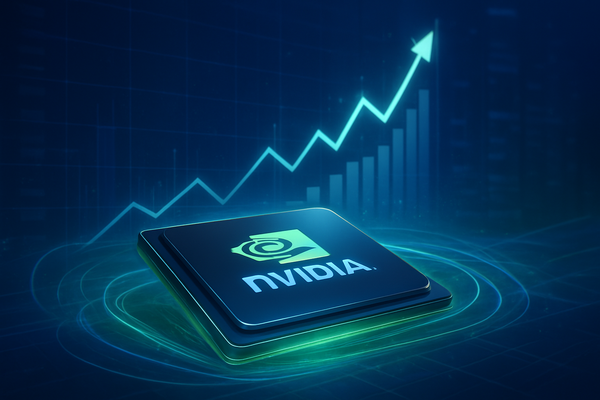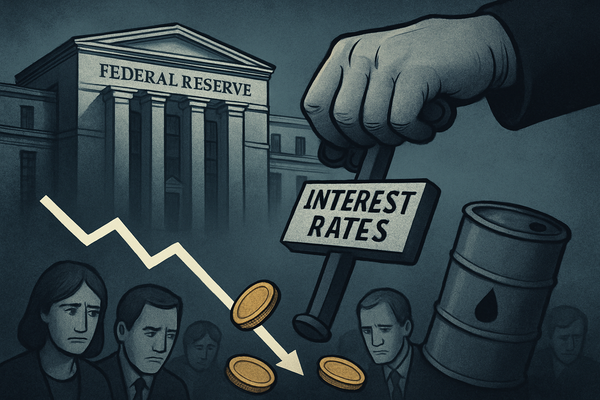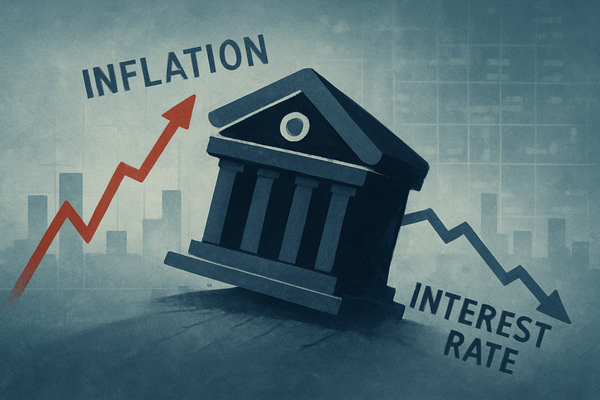S&P 500 and Nasdaq Reel as December Rate Cut Hopes Evaporate

U.S. equity markets are experiencing a significant downturn as expectations for a December 2025 interest rate cut by the Federal Reserve rapidly diminish. Both the S&P 500 and Nasdaq Composite have seen sharp declines in mid-November, signaling a profound shift in investor sentiment towards a "higher for longer" interest rate environment. This recalibration comes as persistent inflation and a hawkish Federal Reserve continue to dictate market narratives, forcing investors to re-evaluate their positions and brace for sustained elevated borrowing costs.
The immediate implications of this vanishing optimism are clear: increased market volatility and a notable "risk-off" rotation. High-growth technology stocks, which often thrive on lower interest rates, have been particularly vulnerable, leading the broader market's decline. The bond market has also reacted in kind, with U.S. Treasury yields rising as the prospect of imminent rate reductions fades, underscoring the market's acceptance of a more restrictive monetary policy stance for the foreseeable future.
Detailed Event Coverage
The dramatic reassessment of a December 2025 rate cut, shifting from a near certainty to a "coin toss" by mid-November 2025, has been meticulously orchestrated by a series of hawkish Federal Reserve communications and complicated by a prolonged government shutdown. While the Federal Open Market Committee (FOMC) had implemented rate cuts in September and October, bringing the federal funds rate to 3.75%-4.00% by October 29, the accompanying rhetoric became increasingly cautious. Fed Chair Jerome Powell, following the October cut, explicitly stated that a further reduction in December was "far from" a foregone conclusion, highlighting "strongly different views" within the FOMC. This sentiment was echoed by a "parade of Fed officials" throughout early November, with figures like St. Louis President Alberto Musalem, Cleveland's Beth Hammack, Minneapolis President Neel Kashkari, San Francisco Fed President Mary Daly, and Boston's Susan Collins all expressing skepticism about the need for immediate additional cuts, citing persistent inflation around 3% and the economy's resilience.
Economic data, or rather the lack thereof, played a crucial role. A prolonged U.S. government shutdown, which only ended on November 12, 2025, severely disrupted the release of critical reports, including October's employment and Consumer Price Index data. This "data fog" left both the Fed and market participants "flying blind," forcing reliance on private data and internal research and making decision-making more challenging. Despite this, the U.S. economy demonstrated continued momentum, with strong Q3 corporate earnings (82% of S&P 500 companies exceeding forecasts) and a largely balanced labor market. The timeline saw market odds for a December cut plummet from nearly 95% a month prior to around 50-53% by November 13, and further to 49.6% by November 14, according to CME Group’s FedWatch tool.
The immediate market reaction was swift and negative. On November 13, the S&P 500 dropped by 1.59% (108.91 points), closing at 6,741.94, while the Nasdaq Composite experienced an even steeper decline of 2.30% (537.47 points), settling at 22,869.43. This sell-off continued into November 14, with the S&P 500 falling an additional 0.90% and the Nasdaq 100 losing 1.17%. Technology and AI-related stocks were particularly hard hit, with companies like Super Micro Computer (NASDAQ: SMCI) (-7.5%), Tesla (NASDAQ: TSLA) (-6.6%), and Palantir (NYSE: PLTR) (-6.5%) seeing significant drops. The bond market simultaneously reacted, with U.S. Treasury yields rising across the curve, reflecting diminished expectations for imminent rate cuts and a "risk-off" rotation by investors pulling capital from high-growth assets.
Companies That Might Win or Lose
The "higher for longer" interest rate environment, now firmly entrenched as December 2025 rate cut hopes fade, creates a distinct landscape of winners and losers across public companies and sectors. Financial institutions are poised to benefit significantly. Banks like JPMorgan Chase (NYSE: JPM) thrive on higher net interest margins, earning more from lending and client cash balances. Insurance and wealth management firms such as Prudential Financial (NYSE: PRU), MetLife (NYSE: MET), and Charles Schwab (NYSE: SCHW) also see improved profitability as their investment portfolios yield more. Certain energy companies, including ConocoPhillips (NYSE: COP) and EOG Resources (NYSE: EOG), have also shown a positive correlation with rising yields. Additionally, dividend growth stocks, demonstrating strong cash generation and lower debt, tend to be resilient, while utilities, despite some rate sensitivity, could see accelerated earnings from growing electricity demand for AI data centers.
Conversely, high-growth technology stocks and sectors heavily reliant on future earnings and external financing are facing significant headwinds. Their valuations, heavily dependent on discounted future cash flows, are negatively impacted by higher discount rates. Tech-heavy indices like the Nasdaq have already registered sharp declines, with bellwether companies such as Nvidia (NASDAQ: NVDA), Oracle (NASDAQ: ORCL), and Tesla (NASDAQ: TSLA) experiencing notable drops. Small businesses and small-cap stocks, represented by the Russell 2000, are also vulnerable as they often depend on bank loans and hold floating-rate debt, making borrowing more expensive and eroding profit margins.
The construction and real estate sectors, including REITs, are highly sensitive to interest rates, with higher borrowing costs stifling new developments and reducing property demand. Apartment construction firms, for example, note that current rates make many projects economically unviable. Consumer discretionary companies face reduced spending as elevated consumer credit rates cut into disposable income. Furthermore, any company carrying substantial debt or facing refinancing needs will see increased interest payments, eroding profitability. This scenario particularly challenges private equity firms, which are being forced to hold investments longer due to high debt costs affecting exit valuations, and could also impact the broader healthcare sector which faces headwinds from new drug pricing rules and public health funding concerns.
Wider Significance
The fading prospects of a December 2025 rate cut and the solidification of the "higher for longer" narrative represent a pivotal moment with wide-ranging implications for broader industry trends. The artificial intelligence (AI) sector, which relies on substantial upfront investment and long-term payoffs, faces increased pressure. Higher borrowing costs squeeze the financial viability of AI companies, particularly startups, leading to greater scrutiny of valuations and a demand for clearer paths to profitability. This could slow highly speculative AI development, favoring projects with more immediate business impact. Similarly, the energy transition, a capital-intensive endeavor for renewable energy projects, is challenged as higher interest rates significantly increase the levelized cost of electricity for renewables, making them less competitive against traditional energy sources.
Ripple effects will be felt across all sectors. Smaller, less established companies, particularly those in technology, will find it harder to secure funding, potentially leading to market consolidation as cash-rich incumbents acquire struggling competitors. Consumer discretionary spending will likely decline as higher borrowing costs for credit cards and loans reduce disposable income. Emerging markets face heightened risks from a stronger U.S. dollar, leading to capital outflows and increased debt servicing costs for dollar-denominated obligations. On the regulatory front, central banks will maintain vigilance against persistent inflation, and policymakers may face calls for fiscal discipline to complement monetary tightening. Higher interest rates also risk limiting the public sector's ability to directly fund the energy transition, necessitating policy adjustments to remove obstacles for low-carbon projects.
Historically, financial markets have navigated similar periods of prolonged higher interest rates. The mid-1990s cycle, where the Fed raised rates to combat inflation before holding steady, offers a parallel to the current environment where initial aggressive rate cut projections have been pared back. The Fed has often kept its target rate unchanged for extended periods, such as from 1992-1994 and 2006-2007. Crucially, significant consecutive rate cuts have historically often followed an economic downturn or crisis. Given the current resilience of the economy, low unemployment, and strong growth, immediate and aggressive rate cuts are less likely, reinforcing the "higher for longer" stance and demanding a re-evaluation of investment strategies that thrived in the era of perpetually low rates.
What Comes Next
The immediate future for the S&P 500 and Nasdaq is characterized by heightened volatility and moderated gains as markets adjust to the "higher for longer" interest rate environment. Short-term possibilities (late 2025 – early 2026) include continued selling pressure on tech and AI-linked stocks due to valuation concerns, while defensive sectors like healthcare, utilities, and consumer staples may show resilience. Despite pullbacks, record amounts of cash in money market funds suggest that "buy the dip" mentalities might persist, indicating underlying investor confidence. Some market cycle analyses even suggest a potential year-end rally for equities extending into December, followed by volatility or correction in Q1 2026.
Looking further ahead (2026 and beyond), the long-term outlook appears more bullish, with robust corporate earnings growth expected to drive both indices. J.P. Morgan Research anticipates double-digit corporate earnings growth of 12-13% for 2025-2026, with S&P 500 earnings potentially increasing 14% in 2026. The Artificial Intelligence (AI) revolution is projected to be a "once-in-a-lifetime" driver, boosting productivity and revenue across various sectors. This could lead to a broadening market rally beyond the "Magnificent Seven" mega-cap tech companies, with small and mid-cap companies contributing more significantly to overall earnings growth, fostering a more sustained and less concentrated market.
Strategic pivots are essential for both companies and investors. Companies must prioritize debt management, refinancing variable-rate debt, and focusing on operational efficiency and profitability over aggressive, debt-funded expansion. Investors should bolster portfolio resilience through diversification, consider fixed income with shorter maturities for attractive yields, and tactically adjust equity allocations, potentially favoring value stocks which tend to correlate positively with rising interest rates. While emerging markets face challenges from a stronger U.S. dollar, those with strong domestic demand and improving fundamentals could present opportunities. Potential scenarios range from a "soft landing" with continued economic resilience, to stagflationary pressures, or even a mild recession, while an extreme bull case driven by AI and potential Fed overstimulation could see the S&P 500 surge to 9,000 in 2026.
Comprehensive Wrap-up
The abrupt evaporation of December 2025 rate cut expectations marks a significant turning point for the S&P 500 and Nasdaq, ushering in an era defined by a "higher for longer" interest rate narrative. Key takeaways include sharp market declines across major indices, particularly in tech, a bond market sell-off leading to rising Treasury yields, and heightened uncertainty exacerbated by economic data disruptions. This shift fundamentally challenges asset valuations, especially for growth stocks, and necessitates a recalibration of investment strategies away from those reliant on perpetually low rates.
Moving forward, the market faces a nuanced and potentially volatile period. While the Federal Reserve is expected to gradually ease rates, the pace will be cautious, with the federal funds rate potentially hovering around 3.6% by the end of 2025. Despite short-term turbulence, the long-term outlook for 2026 and beyond appears more optimistic, driven by robust corporate earnings growth and the transformative potential of the AI revolution. However, current elevated valuations for the S&P 500 and the "Magnificent Seven" tech stocks remain a concern, suggesting that a broader market participation is crucial for sustained gains.
The lasting impact of this period signifies a fundamental shift away from the "easy money" policies of the past. It demands greater financial discipline from companies and a more discerning approach from investors. The market is adjusting to "less comfortable truths" of sticky inflation and a central bank committed to its mandate. Investors should closely watch central bank communications, inflation reports, labor market strength, and corporate earnings guidance. Geopolitical developments, trade policy, and the performance of the "Magnificent Seven" will also be critical. While underlying confidence may lead to "buy the dip" opportunities, investors should prepare for continued volatility and prioritize diversified portfolios as the market navigates this more normalized, yet challenging, interest rate environment.
This content is intended for informational purposes only and is not financial advice



